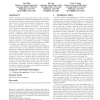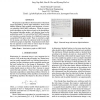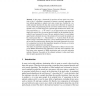173 search results - page 16 / 35 » An optimal randomized algorithm for maximum Tukey depth |
KDD
2010
ACM
13 years 11 months ago
2010
ACM
Feature selection is an important task in order to achieve better generalizability in high dimensional learning, and structure learning of Markov random fields (MRFs) can automat...
ICCV
2009
IEEE
15 years 17 days ago
2009
IEEE
This paper is focused on the Co-segmentation problem
[1] – where the objective is to segment a similar object from
a pair of images. The background in the two images may be
ar...
ICIP
2008
IEEE
14 years 2 months ago
2008
IEEE
We propose an algorithm for the binarization of document images degraded by uneven light distribution, based on the Markov Random Field modeling with Maximum A Posteriori probabil...
CDC
2010
IEEE
13 years 2 months ago
2010
IEEE
We consider the problem of dynamic buying and selling of shares from a collection of N stocks with random price fluctuations. To limit investment risk, we place an upper bound on t...
KI
2006
Springer
13 years 7 months ago
2006
Springer
Abstract. In this paper, a framework for previous and new quasi-exact extensions of the A -algorithm is presented. In contrast to previous approaches, the new methods guarantee to ...



